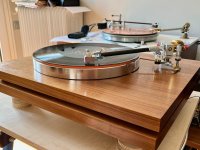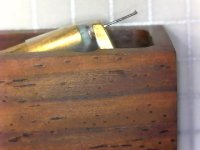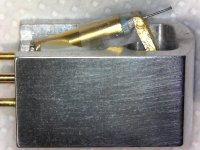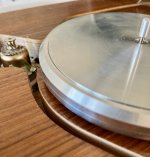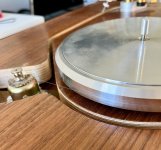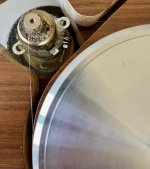Ralph,
I have several failed drives, even SCSI ones, which were supposed to have a higher MTBF (mean time between failures) than 'normal' SATA drives. I would therefore assume that SCSI drives would have the best bearings. Nice idea. I guess I am going to perform some surgery on one of those drives and see if I can successfully remove the bearing, to repurpose it as an idler pulley for the Xerxes.
Thanks for the idea.
I have several failed drives, even SCSI ones, which were supposed to have a higher MTBF (mean time between failures) than 'normal' SATA drives. I would therefore assume that SCSI drives would have the best bearings. Nice idea. I guess I am going to perform some surgery on one of those drives and see if I can successfully remove the bearing, to repurpose it as an idler pulley for the Xerxes.
Thanks for the idea.
Today I decided to test my newly acquired Maxon motor (RE-max 226764). After mounting it on my Xerxes, with two rubber pulleys (one on top of the other, see photo) that I simply glued on the motor shaft, I was confronted with two rather sad observations:
a) the motor is rather noisy. It right out of the box, not run in at all, but sounds like its bearings are worn out. I had not pressed the shaft at all, as I had not press-fitted the pulleys.
b) the maximum speed that I could achieve with my Origin Live controller (after turning the trimmer at maximum) was only 32.09rpm.
I will let the motor run the whole night, just to see whether it improves overnight. But to be honest, I am not so optimistic about the results. 🙁
Any thoughts or advice, please? Thanks in advance.
Panos
P.S. My Premotec runs so quietly that cannot be heard even from one cm distance...!!
Sorry to read this Panos.
It seems a bit beyond belief that MAXON would send a faulty and noisy motor as the direct result of a special "Build on Request" order like this.
Nevertheless, Quality Control - or lack thereof - is a reality of life. All you can do is promptly reconnect with MAXON and seek remedy.
I am very much looking forward to understanding how MAXON responds - and to reading about your prompt receipt of a silky-smooth quiet replacement unit.
Hi Sondeknz,
yes, I am also disappointed that Maxon could not provide a problem-free motor. I am not sure whether it's "build on request" though. My understanding is that the RE-max line is being phased out and there are some motors still available for sale. Someone else may have different information, so do not take my word for it.
In any case, yesterday night I sent an email to Maxon. Hopefully they will respond sometime next week. Let's see what they will propose to remedy the situation. I wonder whether I should go for the same motor model, or request another model from Maxon. Any thoughts?
It's rather worrying that incidents with noisy bearings are not so uncommon with Maxon. Pity for such a reputable company.
Cheers,
P.
yes, I am also disappointed that Maxon could not provide a problem-free motor. I am not sure whether it's "build on request" though. My understanding is that the RE-max line is being phased out and there are some motors still available for sale. Someone else may have different information, so do not take my word for it.
In any case, yesterday night I sent an email to Maxon. Hopefully they will respond sometime next week. Let's see what they will propose to remedy the situation. I wonder whether I should go for the same motor model, or request another model from Maxon. Any thoughts?
It's rather worrying that incidents with noisy bearings are not so uncommon with Maxon. Pity for such a reputable company.
Cheers,
P.
Please do not take that I also have a Maxon with duff bearings as an indictment of Maxon's quality control. The bearings on my knackered motor were definitely damaged by using way to much force when press fitting a pulley.
Bad news is usually followed by more bad news. It seems that my Ortofon Cadenza Black may have suffered a separation of the diamond from the cantilever. So, the universe may be pushing me towards my newly restored Lenco L78 and forget about the Roksan Xerxes. But I am resisting.
I've just replaced the Cadenza with my aluminum Denon DL103R with Namiki boron cantilever and microridge diamond. After the proper alignment, it's the first time I am properly listening to my Xerxes after the upgrade of the Origin Live controller with the bigger Nichicon capacitor and the setting of the power pack to 12V.
So, how does it sound? More stable and 'confident' than in the past. I have the impression that now the controller can better overcome the instant changes of stylus drag and allow a better flow of the music. And the bass has become even stronger. The improvement is not huge, but can clearly be seen (heard) in the details. So, I am happy about that. The change of the capacitor has been a significant upgrade. Many thanks to Sondeknz for the guidance.
Now, I have to see how the issue with the Maxon motor will be resolved and even more importantly how to fix my Ortofon cartridge...
I've just replaced the Cadenza with my aluminum Denon DL103R with Namiki boron cantilever and microridge diamond. After the proper alignment, it's the first time I am properly listening to my Xerxes after the upgrade of the Origin Live controller with the bigger Nichicon capacitor and the setting of the power pack to 12V.
So, how does it sound? More stable and 'confident' than in the past. I have the impression that now the controller can better overcome the instant changes of stylus drag and allow a better flow of the music. And the bass has become even stronger. The improvement is not huge, but can clearly be seen (heard) in the details. So, I am happy about that. The change of the capacitor has been a significant upgrade. Many thanks to Sondeknz for the guidance.
Now, I have to see how the issue with the Maxon motor will be resolved and even more importantly how to fix my Ortofon cartridge...
Beautiful!
I don't really recognize either table, but they look gorgeous.
Well done, Panos!
PS: I'm running a stock DENON DL-103R these days. I'm pretty staggered at how good it is, at NOT huge sums of money. The big DENON could easily become my go-to cart, once our SHELTER 501/2 finally turns up its toes...
I don't really recognize either table, but they look gorgeous.
Well done, Panos!
PS: I'm running a stock DENON DL-103R these days. I'm pretty staggered at how good it is, at NOT huge sums of money. The big DENON could easily become my go-to cart, once our SHELTER 501/2 finally turns up its toes...
Thanks, Sondeknz.
The wooden deck is my Roksan Xerxes with a changed plinth. That's where the Origin Live controller works.
The deck at the back is a restored Lenco L78.
With respect to the DL103R, I have two highly modified ones (different body, different cantilever/stylus). They sound great and can beat cartridges many times the price. If you considering keeping the DL103R, I would strongly recommend to change the body and use an aluminum one. It will make a lot of improvement.
However, my Ortofon Cadenza Black is even better. More refined.
Of course, everything is a matter of taste.
The wooden deck is my Roksan Xerxes with a changed plinth. That's where the Origin Live controller works.
The deck at the back is a restored Lenco L78.
With respect to the DL103R, I have two highly modified ones (different body, different cantilever/stylus). They sound great and can beat cartridges many times the price. If you considering keeping the DL103R, I would strongly recommend to change the body and use an aluminum one. It will make a lot of improvement.
However, my Ortofon Cadenza Black is even better. More refined.
Of course, everything is a matter of taste.
Attachments
Panos,
Thanks for the tip-off.
Where can these alloy cart bodies be had - and for how much.
How much weight did it add over the original body?
Also, how would you describe the sonic improvements of moving from the original DENON DL-103R body to the alloy body?
Thanks for the tip-off.
Where can these alloy cart bodies be had - and for how much.
How much weight did it add over the original body?
Also, how would you describe the sonic improvements of moving from the original DENON DL-103R body to the alloy body?
Sondeknz,
the aluminum body (not just an aluminum cap on top of the plastic body) would cost probably more than 100€. But the improvement is massive. More bottom end, better clarity. I also had my DL103R retipped. Instead of using the stock cantilever and elliptical stylus, I went for a Nakimi boron cartridge and microridge stylus. Both DL103R are not comparable with a stock 103R anymore. Worth spending time and some money to do an upgrade. You will be rewarded.
You may search on e-bay to see what's on offer.
Wood is a less expensive alternative and can also give very good results. You can also find many wood types on eBay, to choose what you prefer.
the aluminum body (not just an aluminum cap on top of the plastic body) would cost probably more than 100€. But the improvement is massive. More bottom end, better clarity. I also had my DL103R retipped. Instead of using the stock cantilever and elliptical stylus, I went for a Nakimi boron cartridge and microridge stylus. Both DL103R are not comparable with a stock 103R anymore. Worth spending time and some money to do an upgrade. You will be rewarded.
You may search on e-bay to see what's on offer.
Wood is a less expensive alternative and can also give very good results. You can also find many wood types on eBay, to choose what you prefer.
I wanted to revert to our earlier discussion about changing the drive pulley configuration of the LP12.
As I see it, there are three viable pulley configurations for the LP12:
TYPE 1. Conventional, single pulley / single belt configuration - variable only by where the motor pulley is located on the top-plate.
TYPE 2. Double-pulley / single belt configuration, with the motor pulley located on one side of the sub-platter - perhaps in the conventional position - and a second "idler" pulley on the opposite side of the sub-platter.
TYPE 3. Triple-pulley / single belt (Vector) configuration, with the motor pulley located on one side of the sub-platter - perhaps in the conventional position - and second and third "idler" pulleys located around the sub-platter forming an equilateral triangle.
It is clear to me that all things being equal - and in line with Niffy's recommendation - TYPE 3 offers the best balance of drive and centred thrust on the main bearing.
That said, TYPE 3 does NOT seem to offer a practical way of adjusting belt tension.
That is to say that with TYPE 3, it would seem critical that an exact equilateral triangle shape must be maintained in order to deliver the perfectly balanced thrust on the main bearing. Any movement of the motor pulley - used to adjust the tension of the belt - would move away from this perfect equilateral triangle to the detriment of the thrust balance.
And as we know, all belts stretch and wear over time, meaning that the perfectly tensioned belt length today, may not provide the perfect belt tension tomorrow.
IMHO, correct belt tension is really critical for optimal LP12 performance - with (almost) drop-off loose tension with a highly elastic and grippy silicone belt delivering the very best performance that I personally have been able to muster.
So where does this leave me?
Do I opt for TYPE 3 configuration and hold a stock of a dozen belts - each differing by 1mm in overall length - to allow for belt wear over time?
Or would it just be easier to opt for TYPE 2 configuration and position the motor in such a way that it "hinges" on just one mount point, to move nearer or further from the sub-platter as varying belt tension requirements demand?
I know I have not considered multiple belts, but this is simply because I cannot imagine a failproof method of ensuring equal belt tension across multiple belts. Also, to my mind, multiple belts provide additional (unnecessary) sub-platter contact providing additional opportunity for unhelpful motor noise to reach the sub-platter.
It's all very tricky.
I welcome all input.
As I see it, there are three viable pulley configurations for the LP12:
TYPE 1. Conventional, single pulley / single belt configuration - variable only by where the motor pulley is located on the top-plate.
TYPE 2. Double-pulley / single belt configuration, with the motor pulley located on one side of the sub-platter - perhaps in the conventional position - and a second "idler" pulley on the opposite side of the sub-platter.
TYPE 3. Triple-pulley / single belt (Vector) configuration, with the motor pulley located on one side of the sub-platter - perhaps in the conventional position - and second and third "idler" pulleys located around the sub-platter forming an equilateral triangle.
It is clear to me that all things being equal - and in line with Niffy's recommendation - TYPE 3 offers the best balance of drive and centred thrust on the main bearing.
That said, TYPE 3 does NOT seem to offer a practical way of adjusting belt tension.
That is to say that with TYPE 3, it would seem critical that an exact equilateral triangle shape must be maintained in order to deliver the perfectly balanced thrust on the main bearing. Any movement of the motor pulley - used to adjust the tension of the belt - would move away from this perfect equilateral triangle to the detriment of the thrust balance.
And as we know, all belts stretch and wear over time, meaning that the perfectly tensioned belt length today, may not provide the perfect belt tension tomorrow.
IMHO, correct belt tension is really critical for optimal LP12 performance - with (almost) drop-off loose tension with a highly elastic and grippy silicone belt delivering the very best performance that I personally have been able to muster.
So where does this leave me?
Do I opt for TYPE 3 configuration and hold a stock of a dozen belts - each differing by 1mm in overall length - to allow for belt wear over time?
Or would it just be easier to opt for TYPE 2 configuration and position the motor in such a way that it "hinges" on just one mount point, to move nearer or further from the sub-platter as varying belt tension requirements demand?
I know I have not considered multiple belts, but this is simply because I cannot imagine a failproof method of ensuring equal belt tension across multiple belts. Also, to my mind, multiple belts provide additional (unnecessary) sub-platter contact providing additional opportunity for unhelpful motor noise to reach the sub-platter.
It's all very tricky.
I welcome all input.
Last edited:
Sondeknz,Panos,
Thanks for the tip-off.
Where can these alloy cart bodies be had - and for how much.
How much weight did it add over the original body?
Also, how would you describe the sonic improvements of moving from the original DENON DL-103R body to the alloy body?
you might want to have a look at that eBay offer. It is currently very cheap, so caution is required. But this is the type of aluminum body that i am talking about.
With respect to the belt issue, I have bought polyester (non-stretch) thread, and following the directions of a video, I've built a polyester belt to replace my rubber belt sourced from Origin Live. As a matter of fact, I've built three different lengths and chose the one that fit best my needs.
Although I was a bit reluctant at first, that the polyester belt would not provide sufficient traction, I have been proven wrong. Despite being extremely thin, it works and sounds absolutely fine. It is at least on par with the Origin Live belt, if not better. And the good thing is that you can make as many belts as you want at the cost of a single thread spool, which is 2000m long (!)
Enclosed some photos of the polyester belt. I hope it is visible.
An inexpensive and reliable solution. Very easy to implement, too.
Although I was a bit reluctant at first, that the polyester belt would not provide sufficient traction, I have been proven wrong. Despite being extremely thin, it works and sounds absolutely fine. It is at least on par with the Origin Live belt, if not better. And the good thing is that you can make as many belts as you want at the cost of a single thread spool, which is 2000m long (!)
Enclosed some photos of the polyester belt. I hope it is visible.
An inexpensive and reliable solution. Very easy to implement, too.
Attachments
Hi,
Cheers
- Denon Alli body - You only get the real effects of adding the alli body when the plastic body is removed.
- Belt - You should try a Mylar belt, serious improvements over the treaded belt.
Cheers
DNic,
you are absolutely right. the Denon aluminum body should replace the plastic one. That's crucial.
With respect to the belt, after trying the polyester thread (which in my opinion works slightly better than the rubber belt), i will also try tape recorder tape and mylar and silicone belt. I am curious about the results... -)
you are absolutely right. the Denon aluminum body should replace the plastic one. That's crucial.
With respect to the belt, after trying the polyester thread (which in my opinion works slightly better than the rubber belt), i will also try tape recorder tape and mylar and silicone belt. I am curious about the results... -)
Well, I am not intending to use cassette tape, but actually mini-dv tape, which is wider (see photo). It is 6mm wide.

When I built a prototype plinth for development of my "vector" drive I made slots in the plinth so that I could experiment with the position of the idlers. My thinking was that as the belt tension on one side of the motor pulley would be slightly higher the location of the idler might need to be adjusted to rebalanced this force. It turned out that exactly 120° spacing between idlers and pulley worked best anyway. A similar idea could be implemented to allow the idlers to be moved to adjust belt tension.It is clear to me that all things being equal - and in line with Niffy's recommendation - TYPE 3 offers the best balance of drive and centred thrust on the main bearing.
That said, TYPE 3 does NOT seem to offer a practical way of adjusting belt tension.
That is to say that with TYPE 3, it would seem critical that an exact equilateral triangle shape must be maintained in order to deliver the perfectly balanced thrust on the main bearing. Any movement of the motor pulley - used to adjust the tension of the belt - would move away from this perfect equilateral triangle to the detriment of the thrust balance.
And as we know, all belts stretch and wear over time, meaning that the perfectly tensioned belt length today, may not provide the perfect belt tension tomorrow.
IMHO, correct belt tension is really critical for optimal LP12 performance - with (almost) drop-off loose tension with a highly elastic and grippy silicone belt delivering the very best performance that I personally have been able to muster.
So where does this leave me?
Even if the idlers and the pulley are not exactly the same distance from the main bearing the resultant side force on the bearing will still be MUCH lower than when not using the idlers. With my deck balancing the belt tension is much more important as my bearing is sleeveless.
I measured the stretch of the belt at my desired tension and calculated the distance around platter, idlers and pulley then made belts to match.
Niffy
Maxon customer support just came back saying that I may return the motor, if I am not happy with how it works for my application. No questions asked. So, bravo to Maxon about their reply.
So, I decided to take short video of the motor running, so that I can have the motor noise documented. So, I connected the motor to the OL controller again, and quite unexpectedly, I was surprised to see that the motor has become significantly quieter. That’s very strange, but it’s not my impression. The improvement is very clear. It’s not as quiet as my old Premotec motor yet, but it has definitely improved a lot since my initial trial. I will still wait for a few days and see how things work out.
Well, finally some positive news... perhaps.
So, I decided to take short video of the motor running, so that I can have the motor noise documented. So, I connected the motor to the OL controller again, and quite unexpectedly, I was surprised to see that the motor has become significantly quieter. That’s very strange, but it’s not my impression. The improvement is very clear. It’s not as quiet as my old Premotec motor yet, but it has definitely improved a lot since my initial trial. I will still wait for a few days and see how things work out.
Well, finally some positive news... perhaps.
- Home
- Source & Line
- Analogue Source
- 12VDC motor for the turntable. Power, torque, PCB questions
